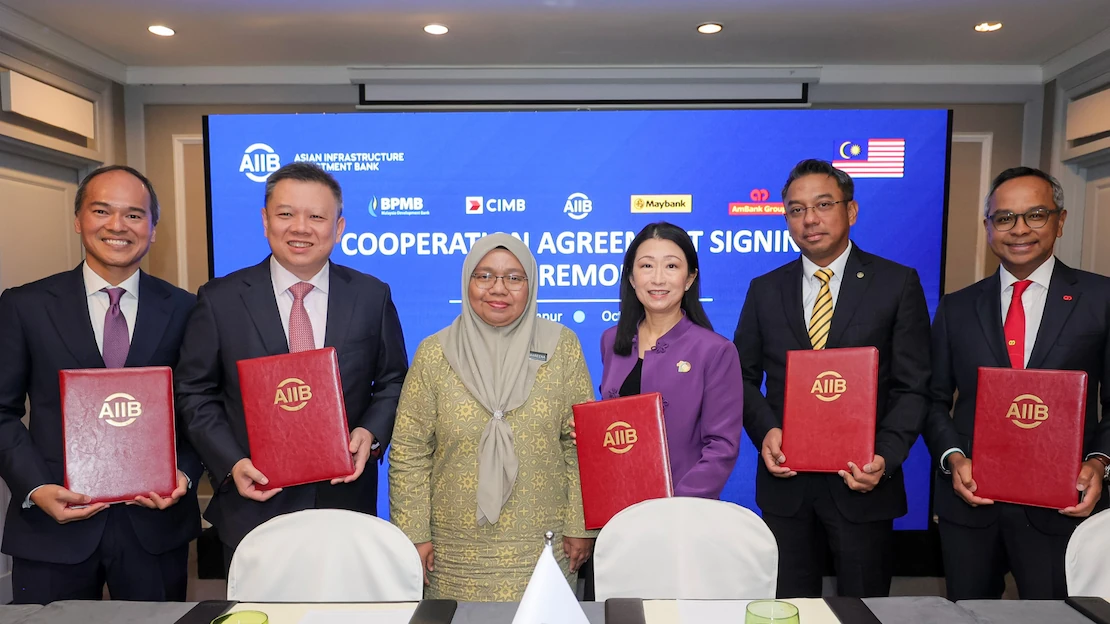AIIB Partners with Maybank, CIMB, AmBank and BPMB to Mobilize up to USD6 Billion for Sustainable Infrastructure – Asian Infrastructure Investment Bank (AIIB)

AIIB and Malaysian Banks Forge USD6 Billion Partnership to Advance Sustainable Development Goals in ASEAN
Executive Summary
The Asian Infrastructure Investment Bank (AIIB) has established a strategic partnership with four leading Malaysian financial institutions: Maybank, CIMB, AmBank, and BPMB. The cooperation agreements, signed following the ASEAN Summit in Kuala Lumpur, aim to mobilize up to USD6 billion. This funding is earmarked for sustainable and technology-enabled infrastructure projects across the ASEAN region, directly contributing to the United Nations Sustainable Development Goals (SDGs).
Core Objectives and Alignment with SDGs
The partnership targets key sectors essential for sustainable development. The initiative combines the regional expertise of the Malaysian banks with AIIB’s capacity for long-term capital financing to advance the following SDGs:
- SDG 7 (Affordable and Clean Energy): Investments will focus on renewable energy projects and the enhancement of power transmission and distribution networks, accelerating the transition to clean energy.
- SDG 9 (Industry, Innovation and Infrastructure): The collaboration will finance resilient transport, digital infrastructure, and telecommunications, fostering regional connectivity and building a foundation for sustainable industrialization and innovation.
- SDG 11 (Sustainable Cities and Communities): By supporting green and inclusive infrastructure, the partnership contributes to the development of safe, resilient, and sustainable urban and rural communities.
- SDG 13 (Climate Action): A central theme of the agreements is financing infrastructure that promotes climate resilience and supports the region’s transition to a low-carbon future.
- SDG 17 (Partnerships for the Goals): The initiative itself is a prime example of a multi-stakeholder partnership, mobilizing private and public capital to achieve sustainable development objectives.
Strategic Initiative: The ASEAN Power Grid (APG)
A significant component of this collaboration is the advancement of the ASEAN Power Grid (APG), a key regional initiative aimed at strengthening energy interconnection and security. AIIB has signaled its intent to provide up to USD2 billion for APG-related investments. This initiative directly supports:
- SDG 7: By creating a cross-border platform for energy trade, the APG enhances access to reliable and clean energy across Southeast Asia.
- SDG 9: The development of the APG constitutes the creation of resilient, high-quality regional infrastructure.
- SDG 13: The grid will facilitate the integration of more renewable energy sources, contributing to regional climate action goals.
The Ministry of Energy Transition and Water Transformation (PETRA) of Malaysia welcomed the partnership as a critical step in mobilizing sustainable finance to accelerate this green infrastructure agenda.
Stakeholder Commitments to Sustainable Development
The participating institutions have affirmed their commitment to financing projects that deliver both economic growth and positive social and environmental impact, aligning with the SDG framework.
- AIIB: Reaffirmed its commitment to financing infrastructure that is green, technology-enabled, and regionally connected.
- Maybank: Aims to accelerate quality investments that drive digitalization and energy resilience while delivering meaningful social impact.
- CIMB: Pledged to catalyze the development of sustainable infrastructure, leveraging its sustainable finance target of RM300 billion by 2030.
- AmBank: Stated its commitment to financing projects that accelerate the region’s transition towards clean energy and climate resilience.
- BPMB: Highlighted its alignment with AIIB in driving sustainable and inclusive growth, catalyzing investments that promote equitable development and support Malaysia’s sustainability agenda.
Partnership Framework and Long-Term Vision
The agreements are set for an initial term extending to October 2031. This long-term partnership is in direct alignment with AIIB’s Corporate Strategy, which has four thematic priorities: green infrastructure, connectivity and regional cooperation, technology-enabled infrastructure, and private capital mobilization. By collaborating with established regional financial institutions, AIIB aims to leverage private sector expertise to scale sustainable solutions that foster climate resilience, economic inclusion, and long-term regional development in line with the 2030 Agenda for Sustainable Development.
Analysis of Sustainable Development Goals in the Article
1. Which SDGs are addressed or connected to the issues highlighted in the article?
-
SDG 7: Affordable and Clean Energy
- The article heavily emphasizes financing for “renewable energy,” the “energy transition,” and creating a “low-carbon future.” A key initiative mentioned is the ASEAN Power Grid (APG), which aims to strengthen energy interconnection and resilience through investments in renewable energy and transmission infrastructure.
-
SDG 9: Industry, Innovation and Infrastructure
- The core subject of the article is the mobilization of capital for “sustainable and technology-enabled infrastructure projects.” It explicitly lists key infrastructure sectors such as “transport, digital infrastructure and telecommunications,” and “power transmission and distribution,” all of which are central to SDG 9. The goal is to build “resilient and forward-looking infrastructure” and enhance “regional connectivity.”
-
SDG 13: Climate Action
- The partnership’s focus on “green infrastructure,” “climate resilience,” and supporting Malaysia’s national goal of “net-zero greenhouse gas emissions by 2050” directly addresses climate action. The investments are intended to accelerate the region’s transition to a “low-carbon future.”
-
SDG 17: Partnerships for the Goals
- The article is fundamentally about a multi-stakeholder partnership. It details a collaboration between a multilateral development bank (AIIB) and several major regional financial institutions (Maybank, CIMB, AmBank, BPMB). The explicit goal is to “jointly mobilize up to USD6 billion” and “catalyze private capital mobilization,” which exemplifies the spirit of SDG 17.
-
SDG 11: Sustainable Cities and Communities
- While not the primary focus, the development of sustainable infrastructure in transport, energy, and digital connectivity is foundational for creating sustainable, inclusive, and resilient communities. The article’s mention of delivering “meaningful social impact” and promoting “equitable development across communities” connects the infrastructure projects to the well-being of human settlements.
2. What specific targets under those SDGs can be identified based on the article’s content?
-
SDG 7: Affordable and Clean Energy
- Target 7.2: Increase substantially the share of renewable energy in the global energy mix. The financing is explicitly aimed at “renewable energy” projects and initiatives like the ASEAN Power Grid to support the “energy transition.”
- Target 7.a: Enhance international cooperation to facilitate access to clean energy research and technology… and promote investment in energy infrastructure. The partnership between AIIB and ASEAN banks is a form of international cooperation to channel investment into clean energy infrastructure.
- Target 7.b: Expand infrastructure and upgrade technology for supplying modern and sustainable energy services. The investment in “power transmission and distribution” and the ASEAN Power Grid directly supports the expansion and modernization of energy infrastructure.
-
SDG 9: Industry, Innovation and Infrastructure
- Target 9.1: Develop quality, reliable, sustainable and resilient infrastructure, including regional and transborder infrastructure. The article’s focus is on financing “sustainable,” “resilient,” and “regionally connected” infrastructure, with the ASEAN Power Grid being a prime example of transborder infrastructure.
- Target 9.a: Facilitate sustainable and resilient infrastructure development in developing countries through enhanced financial support. The AIIB, as a multilateral development bank, is providing significant financial mobilization (“up to USD6 billion”) to support infrastructure development in the ASEAN region.
-
SDG 13: Climate Action
- Target 13.1: Strengthen resilience and adaptive capacity to climate-related hazards. The article states a shared commitment to financing projects that accelerate “climate resilience.”
- Target 13.a: Implement the commitment… to a goal of mobilizing jointly $100 billion annually… for meaningful mitigation actions. The mobilization of USD6 billion for “green infrastructure” and a “low-carbon future” is a direct contribution to climate finance.
-
SDG 17: Partnerships for the Goals
- Target 17.3: Mobilize additional financial resources for developing countries from multiple sources. The partnership is designed to “jointly mobilize up to USD6 billion” and “catalyze private capital mobilization,” directly addressing this target.
- Target 17.17: Encourage and promote effective public, public-private and civil society partnerships. The collaboration between the AIIB (a multilateral institution) and private/national banks is a clear example of a public-private partnership for sustainable development.
3. Are there any indicators mentioned or implied in the article that can be used to measure progress towards the identified targets?
- Total financial mobilization: The article explicitly mentions a target of mobilizing “up to USD6 billion.” This is a direct, quantifiable indicator for measuring progress on financing for sustainable development (relevant to SDG 17.3).
- Investment in specific initiatives: A specific amount of “up to USD2 billion” is mentioned for AIIB’s intended provision for “APG-related investments.” This serves as a concrete indicator for investment in regional clean energy infrastructure (relevant to SDG 7.b).
- Corporate sustainable finance targets: CIMB Group explicitly mentions its own internal indicator: “a sustainable finance target of RM300 billion by 2030.” This is a measurable commitment from a private sector partner.
- National climate goals: The article references “Malaysia’s goal of achieving net-zero greenhouse gas emissions by 2050.” The success of the funded projects can be measured against their contribution to this national-level indicator.
- Project pipeline in key sectors: While not a single number, the development of a pipeline of funded projects in the identified sectors (“renewable energy, power transmission and distribution, transport, digital infrastructure and telecommunications”) serves as an implied indicator of progress.
4. Table of SDGs, Targets, and Indicators
| SDGs | Targets | Indicators Identified in the Article |
|---|---|---|
| SDG 7: Affordable and Clean Energy | 7.2: Increase the share of renewable energy. | Financing directed towards “renewable energy” projects. |
| 7.a: Enhance international cooperation and promote investment in energy infrastructure. | Partnership between AIIB and ASEAN banks to finance clean energy. | |
| 7.b: Expand and upgrade infrastructure for sustainable energy services. | AIIB’s intended provision of “up to USD2 billion for APG-related investments.” | |
| SDG 9: Industry, Innovation and Infrastructure | 9.1: Develop quality, reliable, sustainable and resilient infrastructure, including regional and transborder infrastructure. | Investment in “transport, digital infrastructure,” and the “ASEAN Power Grid” (a transborder initiative). |
| 9.a: Facilitate sustainable infrastructure development through enhanced financial support. | Mobilization of “up to USD6 billion” for infrastructure projects in the ASEAN region. | |
| SDG 13: Climate Action | 13.1: Strengthen resilience and adaptive capacity to climate-related hazards. | Financing projects that support “climate resilience.” |
| 13.a: Mobilize climate finance. | The USD6 billion fund is for “green infrastructure” and a “low-carbon future,” contributing to Malaysia’s goal of “net-zero greenhouse gas emissions by 2050.” | |
| SDG 17: Partnerships for the Goals | 17.3: Mobilize additional financial resources from multiple sources. | The joint mobilization of “up to USD6 billion” and CIMB’s “sustainable finance target of RM300 billion by 2030.” |
| 17.17: Encourage effective public-private partnerships. | The cooperation agreement between AIIB (multilateral) and Maybank, CIMB, AmBank, BPMB (private/national). |
Source: aiib.org
What is Your Reaction?
 Like
0
Like
0
 Dislike
0
Dislike
0
 Love
0
Love
0
 Funny
0
Funny
0
 Angry
0
Angry
0
 Sad
0
Sad
0
 Wow
0
Wow
0



















































.jpg.webp?itok=0ZsAnae9#)


























